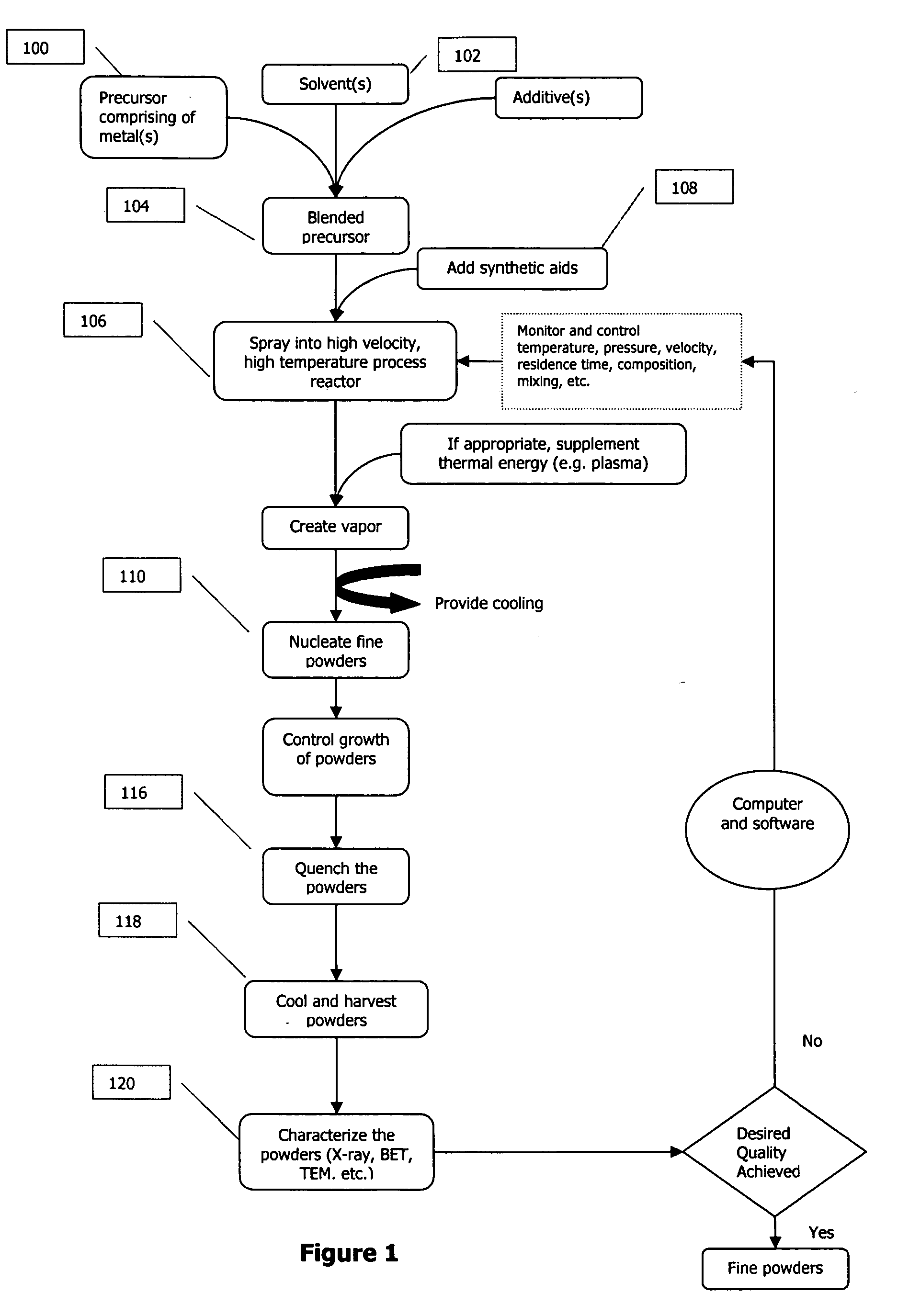Adhesives & sealants nanotechnology
a technology applied in the field of nano-adhesives and sealants, can solve the problems of inability to provide sealing, and inability to meet the needs of other chemical processes, etc., and achieve the effect of high volum
- Summary
- Abstract
- Description
- Claims
- Application Information
AI Technical Summary
Benefits of technology
Problems solved by technology
Method used
Image
Examples
examples 1-2
[0195] Calcium octoate precursor was mixed with Octamethyl cyclotetrasiloxane (OMCT) (0.05:0.95::Ca:Si ratio). This mix was sprayed into a thermal plasma reactor described above at a rate of about 50 ml / min using about 100 standard liters per minute oxygen. The peak vapor temperature in the thermal plasma reactor, processed at velocities greater than 0.25 mach, was above 3000 K. The vapor was cooled and then quenched by Joule-Thompson expansion. The powders collected were analyzed using X-ray diffraction and a surface area analyzer. It was discovered that the powders were amorphous and had a specific surface area of greater than 100 m2 / gm (equivalent average particle size less than 100 nanometers).
[0196] In another step, zirconium octoate precursor was mixed with Octamethyl cyclotetrasiloxane (OMCT) (0.05:0.95::Zr:Si ratio). This mix was sprayed into a thermal plasma reactor described above at a rate of about 50 ml / min using about 100 standard liters p...
examples 3
Calcium Aluminum Oxide Powders
[0198] Calcium octoate precursor was mixed with aluminum octoate precursor such that the metal content of Ca:Al were in 1:2 molar ratios. The mix was diluted with hexane till the viscosity of the precursor was less than 100 cP. This mix was srayed into a thermal plasma reactor described above at a rate of about 60 ml / min using about 120 standard liters per minute oxygen. The peak vapor temperature in the thermal plasma reactor, processed at velocities greater than 0.25 mach, was above 3000 K. The vapor was cooled and then quenched by Joule-Thompson expansion. The powders collected were analyzed using X-ray diffraction (Warren-Averbach analysis) and surface area analyzer. It was discovered that the powders had a crystallite size of less than 100 nm and a specific surface area of greater than 20 m2 / gm. The powder matched the expected diffraction peaks for calcium aluminum oxide.
[0199] This example confirms that nanomaterials of cementing compositions ca...
examples 4
Aluminum Oxide Comprising Adhesive / Sealant Nanocomposite
[0200] 225 mg of aluminum oxide nanoparticles (average crystallite size less than 20 nanometers) were mixed with 525 mg of UV curable adhesive / sealant resin as follows:
[0201] place nanoscale material on a mixing sheet and weigh the nanoscale material added;
[0202] place adhesive resin on the sheet next to the powder and weigh;
[0203] lap, mead and mix the nanoscale material and resin with a spatula to achieve a good consistency formulation;
[0204] place the mixture between two transparent surfaces;
[0205] cure the mixture using the UV gun;
[0206] test the coupon visually for consistency; and
[0207] perform tests for properties.
[0208] 750 grams of uniform adhesive / sealant nanocomposite resulted from this effort.
PUM
| Property | Measurement | Unit |
|---|---|---|
| aspect ratio | aaaaa | aaaaa |
| temperatures | aaaaa | aaaaa |
| temperatures | aaaaa | aaaaa |
Abstract
Description
Claims
Application Information
 Login to View More
Login to View More - R&D
- Intellectual Property
- Life Sciences
- Materials
- Tech Scout
- Unparalleled Data Quality
- Higher Quality Content
- 60% Fewer Hallucinations
Browse by: Latest US Patents, China's latest patents, Technical Efficacy Thesaurus, Application Domain, Technology Topic, Popular Technical Reports.
© 2025 PatSnap. All rights reserved.Legal|Privacy policy|Modern Slavery Act Transparency Statement|Sitemap|About US| Contact US: help@patsnap.com

